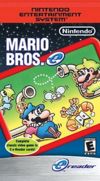Mario Bros.

| |
| Mario Bros. | |
| Developer | Nintendo R&D 1 |
| Publisher | Nintendo |
| System | Arcade, NES, e-Reader, Game Boy Advance, Virtual Console (Wii, 3DS, Wii U), Nintendo Switch Various Non-Nintendo Systems |
| Release Date | Arcade 1983 NES JP September 9, 1983 US June 1985 EU September 1, 1986 e-Reader US November 11, 2002 Game Boy Advance JP May 21, 2004 Virtual Console US November 19, 2006 EU December 8, 2006 JP December 12, 2006 3DS Virtual Console JP May 8, 2013 PAL January 9, 2014 US January 30, 2014 Wii U Virtual Console JP May 29, 2013 US/PAL June 30, 2013 Nintendo Switch September 27, 2017 |
| Gallery | GH Gallery |
| Rating | E |
Mario Bros. is a two-player action game made by [Nintendo]] for the arcade. It is Mario's first game outside of the Donkey Kong series, and the game introduces his brother Luigi as well as the Shellcreeper enemy (which seemed to be a form of the Koopa Troopa, a staple enemy of the later Mario games) and coin-collecting. This game was popular even with the decline of the video game industry at the time, and has been often ported to other systems.
Gameplay
The first player controls Mario (while the second player, if any, controlled Luigi) in exterminating various types of pests which infested the sewers. The game was split up into various phases which was each cleared when every main enemy (the Shellcreepers, the Sidesteppers and the Fighter Flies) were eliminated. The enemies were all beaten in the same way, by jumping into the platform beneath them to flip them over onto their backs, then running up to them and kicking them away. There were also several other enemies (the fireballs and the Freezies) which did not have to be defeated in order to complete a level.
Legacy
This game is known for introducing Luigi and for featuring some elements that would later be incorporated into the Super Mario Bros. games. It is also known as a classic multiplayer game.
Ports and Remakes
- In the 80's, Mario Bros. was ported to the Atari 2600, Atari 5200, Atari 7800, Atari 8-Bit, Apple II and Commodore 64. Most versions featured inferior graphics.
- A Game & Watch game of the same name was released not long after the arcade game. This game was later ported to the Commodore 64 as Mario Bros. II.
- Mario Bros. was released for the NES in the 80's. This version had less detailed sprites.
- The NES version has been released as an unlockable game in 2001's
Animal Crossing, for the e-Reader in 2002, on the Wii's Virtual Console in 2006 and for the Virtual Consoles of the 3DS and Wii U in 2013 and 2014, respectively. It was also released for the Game Boy Advance in 2004 in Japan as part of the Famicom Mini series. In 2016, it was among the games that were included in the NES Classic Edition.
- Mario Bros. appeared in Super Mario Bros. 3 as the two-player Battle Mode. This version replaced the Shellcreepers with Spinies, likely so that players of the Super Mario Bros. games would not be confused into jumping on them.
- An updated version of Mario Bros. was included in Super Mario Advance in 2001. This version allowed up to four players to play, with additions including items from later games and an appearance by an invincible Bowser as an obstacle in one of the multiplayer levels. This version was also included in Super Mario Advance 2: Super Mario World, Super Mario Advance 3: Yoshi's Island, Super Mario Advance 4: Super Mario Bros. 3 and Mario & Luigi: Superstar Saga. Using the system's link cables, any two copies of these games could be used to play multiplayer Mario Bros..
- In 2013, a version of the game known as Luigi Bros. was included as unlockable content in Super Mario 3D World. The primary difference in this version is that Mario is replaced by Luigi, who appears using his modern clothing colors. Luigi is still available as the second player, using his original clothing colors.
- In 2017, the original Mario Bros. arcade game was released as a downloadable game for the Nintendo Switch as part of the Arcade Archives system.
Sequels
The Virtual Boy game Mario Clash was loosely based on Mario Bros..
| Titles in the Mario Series |
|---|
| Donkey Kong (GB) - Jr. - Mario Bros. - Mario Clash Super Mario Bros. (DX) (Lost Levels - 2 - 3) - Super Mario World - Yoshi's Island - Super Mario Land (2) Super Mario 64 (DS) - Sunshine - Galaxy (2) - 3D Land (World) - Odyssey Super Mario Advance (2 - 3 - 4) - New Super Mario Bros. (Wii - 2 - U) - Run - Wonder Mario vs. Donkey Kong - March of the Minis - Minis March Again! - Mini-Land Mayhem! - Minis on the Move - Tipping Stars Mini Mario & Friends: amiibo Challenge - Super Mario Maker (2) |